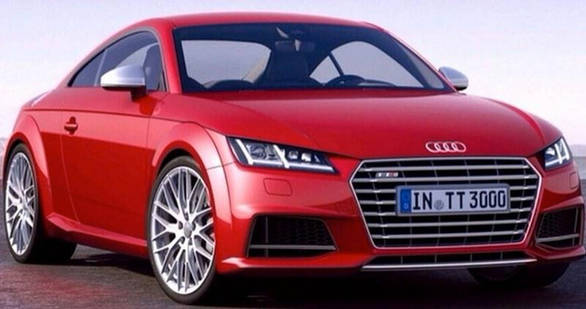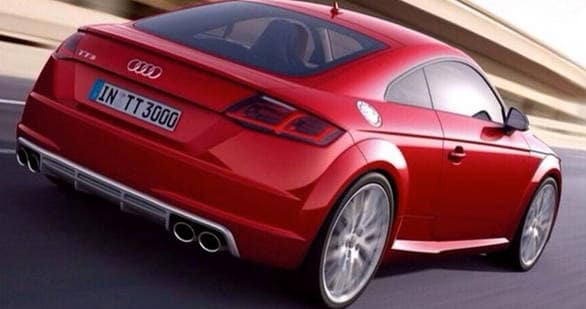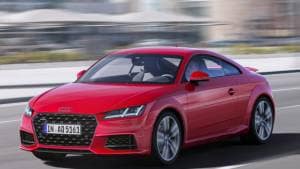Geneva Auto Show 2014: New Audi TT and TTS Coupe revealed
The world premiere of Audi's new TT and the sporty TTS coupe models has taken place at Geneva Motor Show. The new car is the third generation of this iconic machine. The pricing for the model is not yet released but the company says that the first deliveries will take place by the end of this year.
The front end of the car is dominated by the trapezoidal grille which is broader and wider than the previous version. The grille is flanked on the lower side by large air intakes having struts which divert some of the air from the front to the flanks of the car. The bonnet gets two lines which end at the inner edge of the headlight assembly. The headlights themselves come with Xenon plus bulbs as standard while LED come as options.

The side has flared wheel arches with wheels available in 17-20 inch sizes, depending on the model. The coupe has the same length of 4180mm as the second generation but at 2505mm has an extra 37mm of wheelbase. The swooping roofline lends a smooth visual allure along with a distinctly visible shoulder line. On the right side the fuel flap is a classic feature taken from the first generation, the only difference is that there is no filler cap beneath the flap- the pump nozzle directly goes in to the tank neck just like during pit stops in motorsports.
The rear gets round quad exhaust pipes with twin pipes at either end integrated in the diffuser. A spoiler is cleverly concealed in the tailgate and automatically deploys at 119kmph. The tail lights have light guides which act as DRLs and this same design is also seen on the headlamps.
The interior gets a clean and uncluttered look with the designers working with the 'less is more' theme in mind. The centre console looks sleek and minimal probably because the MMI screen and the instrument cluster have been integrated in to one digital unit behind the steering wheel. The air vents have the round traditional TT design and resemble the turbine of jet planes. The vents have a neat feature in which they show the information and also have controls pertaining to the air-conditioning system. The boot area has a luggage holding capacity of 305 litres which can be extended by folding the backrest of the rear seats forwards.
The engine options for the TT are the TDI and TFSI engines. The TDI engine is a 2.0litre, four cylinder unit producing 380Nm of torque. The engine mated to manual gearbox makes the dash to 100kmph in a claimed 7.2 seconds and reaches a top speed of 235kmph. Company claims that the combined fuel efficiency is 28.5kmpl and emissions are just 110g/km.

The petrol is a 2.0litre TFSI unit generating 230PS/370Nm. Matched to a manual transmission and front wheel drive it will sprint from 0-100kmph in 6.0 seconds and go all the way to a top speed of 249kmph.The performance and efficiency figures are further amplified when the S-tronic transmission and Quattro four wheel drive systems are bought from the options list. All the engines come with the Stop & Start functionality as standard to enhance mileage figures.
A beefed up TTS version of the TT has also been unveiled at Geneva. The TTS is powered by the same 2.0litre, four cylinder, TFSI unit but now makes 310PS and 380Nm of torque. The 0-100kmph time comes in a blistering 4.7 seconds. All wheel drive Quattro and adaptive magnetic suspension system is standard on this version.
A NEW BEGINNING FOR THE AUDI TT COUPÉ IN GENEVA
| All-new Audi sports car with high-tech lightweight construction, all-digital virtual cockpit and sub-five-second sprint ability breaks cover All-new TT and 310PS TTS Coupé models set to make their debuts at the 2014 Geneva Show (March 6-16) UK pricing to be confirmed first deliveries in late 2014 Evocatively redesigned body cloaks revolutionary new all-digital 'Audi virtual cockpit' New engines, new suspension configuration and heavily revised quattro system capable of temporarily deactivating to boost efficiency Further improved aluminium and steel hybrid construction processes help to reduce entry level model kerb weight by 50kg TT TDI combines 67.2mpg capability with CO2 output of just 110g/km, yet can also reach 62mph in 7.2 seconds and top out at 146mph (provisional) TTS derives 310PS from 2.0 TFSI unit, and in conjunction with six-speed S tronic transmission can power to 62mph in just 4.7 seconds (provisional) Audi drive select adaptive driving system and Audi magnetic ride damper control standard for TTS Reformulated visually, technologically and dynamically, the all-new Audi TT Coupé and 310PS TTS Coupé are ready to take centre stage at the Geneva Motor Show. The sports car that in 1998 emphatically defined the Audi design philosophy and paved the way for the brand's current phenomenal success has been respectfully updated and comprehensively re-engineered for its third generation. It is again characterised by innovation in construction, engine design and technological input, the latter being particularly evident in its new all-digital Audi virtual cockpit. "The Audi TT is the epitome of an authentic design icon and a top-performance driving machine," explains Prof. Dr. Ulrich Hackenberg, Member of the Board of Management of AUDI AG for Technical Development. "With the new generation, we are making this technology even easier for the driver to experience just as they would expect from a real sports car." Exterior design When the first-generation Audi TT made its debut in 1998 its design was seen as nothing short of revolutionary with its strictly geometrical lines it struck out in a new stylistic direction that arguably changed the course of modern day car design, and it has gone on to achieve iconic status. For the third TT generation, the Audi designers have returned to many of these ideas and placed them in a new context that is as dynamic as it is diverse. The front of the new TT is dominated by horizontal lines. The Singleframe grille is much broader and flatter than that of the previous model, with a powerful line dividing it into two zones. Starting in the top corners of the grille, sharp contours run in a V across the bonnet, which bears the four Audi rings as on the Audi R8 high-performance sports car.** The air intakes feature struts that direct part of the flow away from the front to the flanks. The flat headlights give the new TT's face a determined look. Xenon plus units are standard, with LED headlights or units using the pioneering Audi Matrix LED technology first seen in the A8 luxury saloon available as optional extras. In both versions, there is a clearly defined contour created by the separating strip in the headlights, which is illuminated by light guides. The Matrix LED units each incorporate 12 separate controllable LEDs which form the high beam and can be individually shut off when sensors detect traffic ahead or approaching to 'divert' the beam around other road users without diminishing its effectiveness. These innovative units also integrate dynamic indicators that light up sequentially in the direction in which the driver is steering, and predictive cornering lights that use navigation data to move the cone of light into a bend before the steering wheel is turned. Depending on the version or options chosen, the new TT sits on wheels ranging from 17 inches to 20 inches in size, helping to convey an impression of lean muscularity from the side. At 4.18 metres long, the Coupé is almost exactly the same length as its predecessor, though its wheelbase has grown by 37 mm to 2,505 mm, making for especially short overhangs. It is 1,832 mm wide, and has the same height as the previous model at 1,353 mm. A lot of the details of the new Audi TT's profile are reminiscent of the first-generation of the modern classic. The contour of the sills creates a striking refracting edge, while the broad wheel arches form their own geometric bodies. The front wheel arch breaches the line of the bonnet, which continues over the door as a tornado line and runs almost horizontally through to the tail as a strong body shoulder. The flat glasshouse gives the impression of being an independent unit and the slight kink in the rear side window gives it additional tension. The fuel flap on the right side panel is the classic circle surrounded by socket screws. This shape is again reminiscent of the first-generation TT, although here there is no filler cap beneath the flap. This means that there is nothing to be unscrewed and the pump nozzle slots straight into the tank neck, as in motor racing. At the rear, horizontal lines give the TT real presence. When the optional LED and Audi Matrix LED headlights are specified, the tail lights also have dynamic indicators. In parallel with the headlights, a strip in each tail light also forms a daytime running light contour another Audi innovation. The third brake light is an extremely narrow strip positioned under the edge of the rear spoiler. It plays an essential part in defining the tail light silhouette. All 'standard' models have two large round exhaust tailpipes which are again reminiscent of the original TT. Like all Audi S models, the TTS exhales through four oval tailpipes. At Autobahn-legal speeds of in excess of 74mph, a spoiler extends from the boot lid to improve both air resistance and downforce. As in the outgoing model, S line specification will bring its own exclusive design for the bumpers, air intakes, Singleframe grille, sills and rear diffuser, plus even sharper handling courtesy of larger wheels and the no-cost option of 10 mm lower S line sports suspension. Body Lightweight construction is one of Audi's greatest areas of expertise. The second-generation Audi TT already featured an Audi Space Frame (ASF) body comprising aluminium and steel. For the new TT, Audi has taken this composite construction principle even further, in line with its philosophy of 'the right amount of the right material in the right place for optimal functions'. The Coupé's underbody structure has optimised axle loads and is made of modern, high-strength and ultra-high-strength steel alloys. In the sections of the passenger cell that are subject to the most structural stress, form-hardened steel panels, which are both ultra-high-strength and light are used these constitute 17 percent of the body's weight. The side sills and roof frame are made of extruded aluminium profiles that are integrated into the structure using cast aluminium nodes. This structural principle creates a very rigid and safe bodyshell. The aluminium side sections and roof complete the structure. The bonnet, doors and hatch lid are also made of this light metal. All in all, Audi engineers have, for the second time in a row, succeeded in significantly reducing the unladen weight of the Audi TT. For the second generation model in 2006, up to 90 kg was saved, and the 2.0 TFSI engine variant of the new TT weighs just 1,230 kg. This makes it around 50 kg lighter than its predecessor. The low overall weight is further proof of Audi's expertise in lightweight construction. It impacts particularly positively where acceleration, handling and fuel consumption are concerned. Interior The interior of the new Audi TT is the embodiment of its pure sports car character. As in the exterior, flowing curves, notably in the centre tunnel console and door panels, are combined with horizontal lines and surfaces that emphasise width. In the cabin the designers worked on the basis of "less is more", just as they did externally. Pure, clean lines underscore both the lightness and the uncompromising focus of the car. They are particularly evident in the impressively slender instrument panel, which has been made possible by combining the instrument cluster and MMI screen in a central, digital unit the so-called Audi virtual cockpit and by repositioning the controls for the air conditioning system in the air vents. Seen from above, the instrument panel resembles the wing of an aircraft; the round air vents a classic TT feature are reminiscent of jet engines with their turbine-like design. The vents also contain all the controls for the air conditioning system, including seat heating where applicable, temperature, direction, air distribution and air flow strength; as an option they can also house small digital displays which show the chosen setting. The horizontal control panel is located under the central air vents. The 3D-designed toggle switches activate the hazard warning lights, control the Audi drive select adaptive dynamics system and operate other assistance functions, where specified. The standard sports seats in the new Audi TT have integrated head restraints and are positioned lower than their predecessors in the outgoing model. They are also more than five kilograms lighter. As an option and as standard in the TTS there are newly developed S sport seats with highly contoured and pneumatically adjustable side sections that are exceptionally comfortable and provide excellent support. The new multifunction steering wheel has a flattened rim, and aluminium-look clasps encompass the spokes. It also has a driver airbag that takes up 40 percent less space without compromising safety, and hence emphasizes the sense of visual lightness. Countless details demonstrate the considerable emphasis which Audi places on interior design and craftsmanship. They include the newly designed, split gear lever, the very precisely engaging MMI rotary pushbutton and the finely finished loudspeaker covers with light guides in the optional Bang & Olufsen sound system. As a 2+2 seater, the new Audi TT is a sports car that is suitable for everyday use. The load area has a capacity of 305 litres, which is 13 litres more than before, and can be extended by folding the rear seat backrests forwards. Colours and equipment The new Audi TT offers a far more distinct and vivid range of colours than its predecessor. There are 11 exterior colours, one of which is exclusively reserved for S line models. Seven of the colours in the range are new for the TT, and two of these are completely new for Audi: Nano Grey and Tango Red. There are also two additional paints available for the TTS crystal-effect Panther Black and the highly expressive Sepang Blue. There is a completely new range of colours for the interior, too the Audi TT and the TTS each offer a choice of three interior colours. For the first time, Audi is offering a two-tone interior including contrasting stitching for S line models. The equipment for the new Audi TTS includes extended interior elements that add individually selectable colour accents to the S sport seats clasps, the sides of the centre console and the rings of the air vents. There are numerous options for customisation, including upholstery in various cloths and leather grades, as well as three leather packages. The S sport seats have characteristic diamond quilting in the centre section. One special highlight is the exclusive design selection which comprises a combination of two fine leather colours: dark murillo brown on the seats and a slightly metallic shimmering stone-grey pearl on the armrests, knee supports and cowl. Alternating contrasting stitching, dark aluminium, matching paint for the extended interior elements and a special woven floor mat are further features of this elegant upholstery and trim. For the TTS, the Audi designers have created an innovative technical laser texture for the wings of the instrument panel: It has a honeycomb-patterned, slightly raised surface that gives the Audi TTS a unique feel. Controls and displays The primary aim in designing the interior of the new TT was to make all key controls easily accessible to the driver in a way which eliminated the need to reduce focus on the act of driving as much as possible. In the flagship TTS model, for example, almost all features can be operated via the newly developed multi-function steering wheel, so the driver rarely needs to avert his or her eyes from the road. The second control unit is the MMI terminal on the console of the centre tunnel, which is also a new development. Two toggle switches activate the navigation/map, telephone, radio and media menus. There are two buttons on both sides of the central rotary pushbutton, supplemented by a main menu and a back button. In versions equipped with MMI touch (part of the Connectivity package) the driver can easily enter destinations using the touchpad on the top of the rotary pushbutton. It is also possible to scroll through lists or zoom in on maps. The menu structure of the MMI resembles that of a smartphone, including the free-text search. All important functions can be accessed directly. One special highlight is the MMI direct search. This enables you to start writing immediately when navigating, without having to use a set form. In most cases, inputting four letters is enough to call up destinations throughout Europe. The two side buttons activate context-dependent functions (right button) and options (left button). As an alternative to the control panel, the Audi TT is also equipped with a voice control system. Audi is also breaking new ground in this area, too. For the first time in the Audi TT, natural voice controls are used that enable simple commands such as "Take me to London" or "I want to talk to Julie" to control the vehicle systems without the need to remove a hand from the steering wheel. In the new TT the Audi virtual cockpit replaces conventional analogue displays this fully digital instrument cluster sets new standards with its dynamic animations and precise graphics. Drivers can choose between two display modes: In the classic view, the speedometer and rev counter are in the foreground; in "infotainment" mode the virtual instruments are smaller. The space that becomes free as a result provides ample room for other functions, such as the navigation map. In the Audi TTS there is a third mode in which the centrally positioned rev counter dominates the display. With a resolution of 1,440 x 540 pixels, the 12.3" TFT screen displays brilliantly sharp images. At work in the background is a Tegra 30 graphic processor from market leader Nvidia's Tegra 3 series. At the lower edge of the Audi virtual cockpit, the displays for outside temperature, time and mileage are permanently visible. Warning or information symbols are also displayed there. Engine (All consumption and output figures are provisional) At launch the new TT and TTS will be available with three four-cylinder engines featuring turbocharging and direct injection. Their power outputs range from 184PS to 310PS. The two TFSI petrol engines and the TDI combine plentiful power with trailblazing efficiency, and all feature a start-stop system as standard. The 2.0 TDI is equipped with a manual gearbox and front-wheel drive. Helped by a strong torque peak of 380 Nm (280.27 lb-ft), this new sports car can accelerate from 0 to 62mph in 7.2 seconds and reach a top speed of 146mph, yet is also good for up to 67.2mpg according to the combined cycle test, which translates into CO2 emissions of 110 g/km, a new record low level in the sports car world. The 2.0 TDI features two balancer shafts in the crankcase, adjustable camshafts and a common rail injection system delivering maximum pressure of 2,000 bar. The Audi TT 2.0 TDI meets the Euro 6 standard and, thanks to its high efficiency, is classified as one of the new range of Audi 'ultra' models, which also includes A4, A5 and A6 variants. The 2.0 TFSI is available in two versions a 230PS version for the TT and a 310PS version for the TTS. In both it unites various ultramodern technologies the additional indirect injection supplementing the direct injection of the FSI, the Audi valvelift system (AVS) to adjust the valve stroke on the exhaust side and thermal management, which uses a rotary valve module and an exhaust manifold integrated into the cylinder head. In the Audi TT, the 2.0 TFSI delivers torque of 370 Nm (272.90 lb-ft) from 1,600 to 4,300 rpm. It powers the Coupé which has a six-speed manual transmission and front-wheel drive from 0 to 62mph in 6.0 seconds, and on up to an electronically governed top speed of 155mph. Equipped with the six-speed S tronic transmission and quattro all-wheel drive, performance is even more spirited: the sprint from 0 to 62mph takes 5.3 seconds; top speed is 155mph; in this version combined economy tops out at 41.5mpg with CO2 emissions of 159 g per km. The dual-clutch transmission shifts through the six gears without any noticeable interruption in traction, and in manual model it can be controlled by paddles on the steering wheel. When the Audi drive select system is set to its 'efficiency' mode, the S tronic transmission decouples and 'freewheels' each time the driver takes his or her foot off the throttle pedal. Naturally the Audi TTS is the peak performer. It covers the standard sprint in 4.7 seconds, and its top speed is electronically governed at 155mph. Here, the 2.0 TFSI produces 380 Nm (280.27 lb-ft) of torque between 1,800 and 5,500 rpm. Controllable flaps in the exhaust system modulate the sound and make it even richer. A manual transmission is standard, with an S tronic transmission incorporating launch control, which regulates maximum acceleration from a standstill, available as an option. quattro drive In time-honoured fashion, quattro permanent all-wheel drive delivers additional high speed composure and traction in the new Audi TT. Featuring an electro-hydraulically controlled multi-plate clutch mounted on the rear axle, the system has been further refined for use in the latest iteration of the sports car. A newly designed hydraulic pump reduces weight by around 1.5 kg compared with the previous model, and the software that determines the level of torque distribution between the front and rear axles in fractions of a second has been completely redeveloped. The innovative control system continuously senses the ambient conditions, driving status and the driver's wishes. This means that the ideal distribution of torque is calculated and the TT's dynamic drive characteristics enhanced in every situation. By networking quattro drive with Audi drive select, the driver of the new Audi TT can adjust the operating parameters of the all-wheel-drive system to suit his or her individual requirements. In "auto" mode, optimum traction and balanced driving dynamics are given priority. In "dynamic" mode, torque is distributed to the rear axle earlier and to a higher degree. Efficiency was also given high priority during the optimisation process for the quattro system. In the drive select "efficiency" mode the torque distribution is adjusted to optimize the level of efficiency. The system can precisely determine driving conditions and driver type and can temporarily shut down the quattro system if conditions suit this. In this operating state, the intelligent software carefully monitors the driving situation and reactivates the all-wheel drive before torque is once again required at all four wheels. In this way, quattro drive provides optimum efficiency along with a level of traction and dynamic handling that is typically quattro. Chassis The chassis also reflects the technological expertise behind the new Audi TT. The front suspension is based on a McPherson system; aluminium components reduce the weight of the unsprung chassis masses. The four-link rear suspension can process the longitudinal and transverse forces separately. One particular highlight is the new third generation of the Audi magnetic ride adaptive damper control system. The system, which is fitted as standard to the TTS and optional for all other versions, is unique in this market segment. Compared with the previous version, Audi magnetic ride has been improved in terms of characteristic spread, control dynamics and precision as well as user friendliness. It offers Comfort, Auto and Dynamic modes available via Audi drive select, and makes the compact sports car hug the road more tightly and travel even more smoothly on broken surfaces irrespective of the mode selected. The technology delivers ultra-swift wheel-selective control of the damper forces, which means that in all driving situations there is optimum contact between wheel and road. Another highlight is the standard progressive steering its rack is designed such that the ratio becomes more direct as the steering is turned. In this way, the new TT can be steered precisely with little movement of the steering wheel in urban traffic and on winding country roads. The electromechanically driven and thus highly efficient progressive steering adapts its assistance to speed and forms the basis for the optional assistance systems Audi active lane assist and park assist. With its elaborate chassis design and firm setup, the new Audi TT handles superbly in all situations. The body is lowered by 10 mm in S line versions, in the TTS, and wherever Audi magnetic ride is fitted. The Audi drive select adaptive driving system is an option for the new Audi TT, and standard for the TTS. It primarily controls the engine characteristics and the steering assistance across comfort, auto, dynamic, efficiency and individual modes, but it can also influence the operating parameters of the S tronic transmission, quattro drive, the Audi magnetic ride system and the sound modulating flaps in the exhaust, where these are fitted. In efficiency mode, the operation of the air conditioning and start-stop system can also be fine-tuned via Audi drive select. The button-operated electromechanical parking brake acting on the rear wheels is another new TT feature which is standard across the board. Speed modulation is very effectively taken care of by disc brakes, which at the front are ventilated and have a diameter of up to 338 mm depending on model. The TTS uses newly developed aluminium fixed-caliper brakes to slow the front wheels; these are five kilograms lighter than on the predecessor model another example of Audi's expertise in lightweight construction. The electronic stabilization control (ESC), which can be switched off either partly or completely, perfectly complements the car's sporty handling. When driving through bends, torque vectoring takes effect. If required, torque is distributed from the inside front wheel to the outside front wheel (front-wheel drive) or, on quattro models, to the rear wheels, too. Thanks to the difference in propulsive forces, turn-in to corners is very easy, which is helpful for the driver. In this way, bends can be navigated with great precision and neutrality. ESC also offers a Sport mode which supports more committed driving, facilitating steering and control at high speeds. Equipment All versions of the new Audi TT Coupé come with a generous range of standard equipment, including the MMI radio and the electromechanical parking brake. Alongside the S sports seat with numerous leather and trim variants, options include the advanced key for effortless unlocking and starting, hill hold assist, high-beam assist, the LED interior lighting package, front seat heating, and the storage and luggage compartment package. On the infotainment front, customers can choose from a wide range of options. The connectivity package features the touchpad-based MMI touch system. At the top of the modular range is the MMI Navigation plus with its large flash memory, two card readers, DVD drive, Bluetooth interface and voice control system. The Audi connect system complements the MMI Navigation plus perfectly it connects the new TT to the internet using the fast LTE transmission standard. The integrated Wi-Fi hotspot means passengers can surf the internet and e-mail as they please, while the driver can rely on the customized Audi connect services. The infotainment package is rounded out by attractive components. The Audi Phone Box conveniently links mobile phones phone to the car. Its centrepiece is a universal planar antenna which is integrated into the storage tray in the centre armrest. Thanks to close-range coupling, the phone communicates with the flat planar antenna, which uses an amplifier to transmit the signals to the car antenna. The Bang & Olufsen Sound System features a 14-channel amplifier and 12 loudspeakers; the woofers in the doors are illuminated by an adjustable, discrete light conductor. Highly intelligent assistance systems make driving the new TT an even more pleasurable experience. As an option the car can be equipped with Audi side assist, which uses rear-mounted radar sensors to help drivers change lane more safely; camera-based traffic sign recognition; Audi active lane assist, which helps the driver if required by steadily correcting steering or warning him or her if there is a danger of unintentionally drifting out of lane; the park assist system with display of surroundings, which independently guides the car into suitable spaces; and the Audi pre sense basic safety system. | |
Starts Rs 63.12 Lakhs
1984cc
Automatic
230
370
14.33 Kmpl
Starts Rs 2.55 Crore
5204cc
Automatic
610
530
7.63 Kmpl













